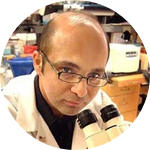How I Serve
I search for emerging companies, technologies, disruptive technologies,
innovations, start-ups and up-starts. I’ll look to match potential problems…
e.g. “plastic pollution” to solutions… e.g. 3D Printer for recycled plastic waste…
for potential venture capitalists, angel investors, and online funders.
I’ll also highlight a variety of topics including funding success stories,
the environment, housing, medical, artificial intelligence, science,
aging populations, disabled populations, social entrepreneurs, philanthropy,
and topical news. I’m always searching for great people innovating,
inventing, and doing, great things.
The 411: Investment Opportunity - From Mice to Men (and Women)
Found on: - https://experiment.com/projects/can-hair-loss-be-reversed-with-oxy133-a-sterol-based-drug-candidate?s=discover
About This Project
Hair loss can affect both men and women, often leaving a negative impact on the affected person’s life. Stem cells associated with hair follicles drive normal hair growth but lie dormant in bald spots. We propose to test topical applications of Oxy133, a drug candidate that can safely increase Hedgehog signaling, in a mouse model of hair growth. We hypothesize that dormant hair stem cells will be stimulated by Oxy133, resulting in increased hair growth in mice and (eventual) human testing.
Ask the Scientists
JOIN THE DISCUSSIONWhat is the context of this research?
Available drug treatments for hair loss (Propecia, Avodart or Rogaine) are modestly effective at best and often plagued by unpleasant side effects. In male pattern baldness, hormonal and other factors lead to a shortened growth (anagen) phase of the hair follicle, resulting in deactivated hair stem cells and diminished hair growth. To regrow lost hair, it may be possible to reactivate dormant hair stem cells by stimulating their cellular signaling. The Hedgehog signaling pathway provides a cellular signal crucial for hair growth that can trigger hair follicles to reenter an active growth phase. At MAX BioPharma, a startup company based in Santa Monica, California, we have developed Oxy133, a drug candidate that can stimulate Hedgehog signaling through a safe ‘allosteric’ mechanism.*
What is the significance of this project?
It is estimated that 40 million Americans suffer from hair loss.* Most hair loss is actually caused by a lack of hair regrowth rather than the increased shedding of hair. Available treatment options typically work far better to prevent further hair loss than to regrow lost hair. This project will address the question whether Oxy133 can safely stimulate hair stem cells in mice and trigger increased hair regrowth. In principle, this application could translate into a hair growth treatment for humans, as Hedgehog signaling functions similarly across species.* Successful experimental outcomes would then allow us to partner with pharmaceutical and cosmetic companies, as well as investors, to further develop the drug and advance to human testing and eventual commercialization.
What are the goals of the project?
The immediate goal of the project is to test the ability of Oxy133, a sterol based activator of Hedgehog signaling, to enhance hair growth in mice through topical application of the compound, a simple but effective model of hair regrowth. We believe that Oxy133 is highly suited for dermatological applications due its high solubility in skin oil. If successful, this pilot study will provide data that can be presented to potential industry partners and investors who will help us develop the technology for commercialization. The long term goal of this project is to offer a new, safe and effective treatment option to people suffering from hair loss.
Budget
There are standard costs that go along with animal experimentation. $5,000 would cover all costs from creating more of the drug candidate for use, housing the mice, paying the scientists, applying the drug, recording the results, and maintaining the lab.


No comments:
Post a Comment